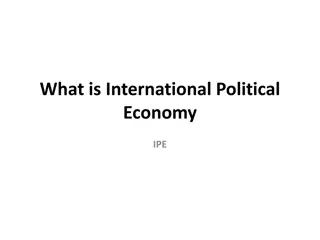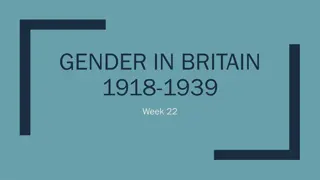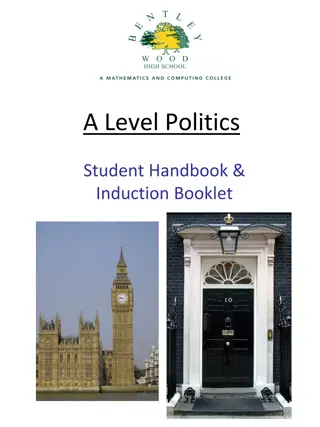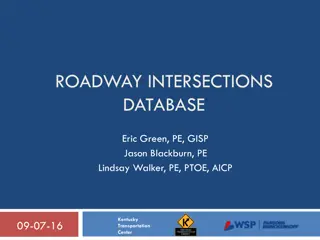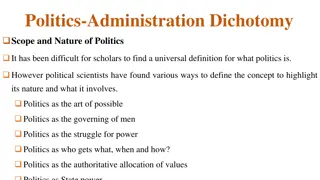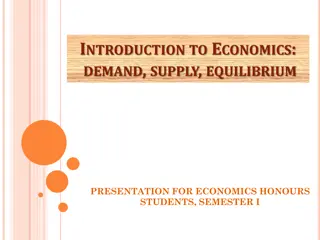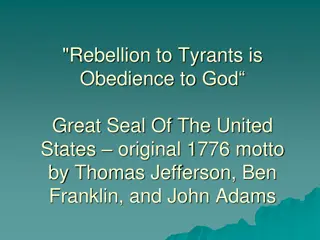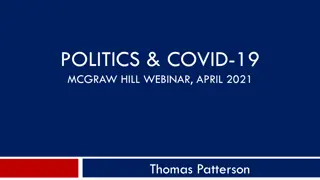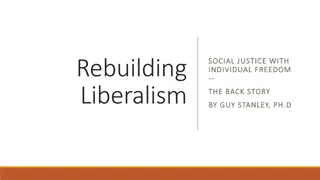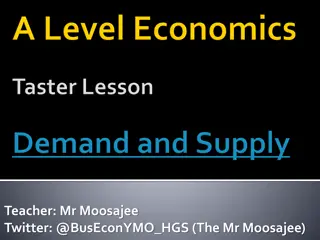Understanding the Intersection of Politics and Economics in Society
Explore the complex relationship between politics and economics through the lens of political economy, examining how these disciplines intersect in shaping governance, public policy, and societal welfare. Delve into the significance of combining political science and economics for a holistic understanding of development processes and power dynamics within nations.
Download Presentation

Please find below an Image/Link to download the presentation.
The content on the website is provided AS IS for your information and personal use only. It may not be sold, licensed, or shared on other websites without obtaining consent from the author. Download presentation by click this link. If you encounter any issues during the download, it is possible that the publisher has removed the file from their server.
E N D
Presentation Transcript
Political Economy of Agriculture Conceptual Ideation Depinder Singh Kapur Presented at a lecture on Political Economy at Shiv Nadar University
What is a Political Economy Framework Political economy uses methods from economics, sociology and political science to understand how a country or a specific programme is managed and performs, and to understand the relationships between economic processes, political policies, and social institutions ODI, 2005 Political economy is an interdisciplinary branch of the social sciences that focuses on the interrelationships among individuals, governments, and public policy
Political economy, branch of social science that studies the relationships between individuals and society and between markets and the state, using a diverse set of tools and methods drawn largely from economics, political science, and sociology. The term political economy is derived from the Greek polis, meaning city or state, and oikonomos, meaning one who manages a household or estate. Political economy thus can be understood as the study of how a country the public s household is managed or governed, taking into account both political and economic factors. Brittannica
What is a political economy framework of analysis? Can we separate what is economic and what is political - in the development of a nation or of any sub system agriculture, industry, culture, sport? Is economic only about demand and supply, determining the price of commodities? Or is it about understanding how production and pricing can be done to ensure maximum reach and welfare of the people. Is politics only a study of the constitution and laws, government formation, elections, political parties and structures and institutions of the state judiciary, executive and legislature? Or is it about contestation for power that is expressed through political institutions both formal and informal? Can economics and politics be separated in any filed of study. Whether Social(caste, gender, backwardness, etc), a Production process(small, medium and large industry, infrastructure, service sector or agriculture) or economic development(of a nation or a region/state)? Why people are uncomfortable in combining politics and economics?
Why a hesitation of combining political science and economics? Because it appears as two distinct disciplines. Experts do not make the inter connections and it is taught so in schools and universities. Requires relating a set of Values/Norms/Desired outcomes( that is political) with analysis of economy and its trends, while studying society and development Requires a historical approach of study
Political Economy Framework - key considerations Historical, current and future development pathway of a nation or any sub system of agriculture, industry or society What exists today is not the end of the world Economic Development is itself a political process. You cannot change economic policies without political backing Economics and politics were never separate. The separation of politics and economic, as two distinct fields, occurred after the Classical Economists Adam Smith, Ricardo and Marx. An understanding of what constitutes national politics - What constitutes the state. What is political power, is it just electoral or is it based on economic power? Where is the contestation happening within this system within the existing power relations and those who are opposing the system Integrating all factors. Identifying the primacy of political or economic factors. Not negating the environmental, cultural and psychological factors.
PE Framework Understanding the historical trend of change : growth/decline Identifying the enabling factors for this change technological, economic, institutional, political Identifying the predominant factor/variable for the Identifying the key actors and the roles they played. Understanding the context in which they succeeded or failed change How did the change impact different sections of society. Was there any duality or dichotomy of impact social, environmental, economic, political. What is the next level of contradiction/dichotomy that is emerging, what are the next level of economic, social and environmental challenges, key political forces/actors and their political base.
What Is Political Economy? Adam Smith, David Ricardo, and John Stuart Mill are widely regarded as the originators of modern themselves political economists, and Mill s Principles of Political Economy was the fundamental text of the discipline from its publication in 1848 until the end of the century. These early theorists could not conceive of the economic and political worlds as separate. economics. But they called IMF https://www.imf.org/external/pubs/ft/fandd/2020/06/political- economy-of-economic-policy-jeff-frieden.htm
What is Classical Economics Classical economics or classical political economy : was represented by political economists Adam Smith, Jean-Baptiste Say, David Ricardo, JS Mill and Robert Malthus. Emerging in the late 18thcentury at the advent of industrial revolution in England. Tried to explain how the national economic growth takes place through the efficient division of labour, without regulation from the King or Feudal power. Adam Smith s work on An Enquiry into the Nature and Causes of the Wealth of Nations , 1776 explained the origin of the wealth of a nation describes in five chapters: Causes of improvement of productive powers of labour and how benefits and natural distributed among all. Principle of Division of Labour. Capital stock and its role in allocation of quantities of labour Policies favouring development of industry and agriculture Theories of political economy that the sovereign rulers Revenue and expenditures of the state/sovereign rulers. Expenses of rulers that are justified. Understanding of causes of sovereign debt and its impact on the nation.
Market - as the invisible hand of god The Invisible Hand is a concept that describes the unintended greater social benefits and public good brought about by individuals acting in their own self-interests.First introduced by Adam Smith in his work Theory of Moral Sentiments , 1759. Akin to invoking divine providence as the hand of god, that somehow makes the markets function for benefit of all.
As every individual, therefore, endeavours as much as he can both to employ his capital in the support of domestic industry, and so to direct that industry that its produce may be of the greatest value, every individual necessarily labours to render the annual revenue of the society as great as he can. He generally, indeed, neither intends to promote the public interest, nor knows how much he is promoting it. By preferring the support of domestic to that of foreign industry, he intends only his own security; and by directing that industry in such a manner as its produce may be of the greatest value, he intends only his own gain, and he is in this, as in many other cases, led by an invisible hand to promote an end which was no part of his intention. Nor is it always the worse for the society that it was not part of it. By pursuing his own interest he frequently promotes that of the society more effectually than when he really intends to promote it.
What is Neo Classical Economics Neoclassical economics is a broad theory that focuses on supply and demand as the driving forces behind the production, pricing, and consumption of goods and services. It emerged in around 1900 to compete with the earlier theories of classical economics. One of the key early assumptions of neoclassical economics is that utility to consumers, not the cost of production, is the most important factor in determining the value of a product or service. This approach was developed in the late 19th century based on books by William Stanley Jevons, Carl Menger, and L on Walras.
History of economic thought ...the history of economic thought about ecosystems/nature..(E. Gomez-Bagethun etal 2009; Fig 1)
Shift from Classical to Neo-classical economics - a slow move of the primary focus on land and labour towards the factors (of production) labour and capital - a move from physical to monetary analysis - a move from use values to exchange values
Critique of Political Economy - Marx Demystifying the invisible hand . Explained the working of the new political economy without the need to look for moralistic justification for its working self interest of individual leads to societal benefit , theories and fair revenues of sovereign rulers . The consciousness of men depends on their existence, and not the other way around Advances Adam Smith contribution to Political Economy : that it is Labour that creates value . To the understanding of emergence of Commodities and Capital thus created in a large market economy where many commodities are now brought and sold as Exchange Value vs. Use Value . That now provide the basis for a new social consciousness in terms of human values and thinking that is very different from the feudal era. That just like physical world/sciences, the social and economic phenomena are also law governed, can be mediated and is not god ordained. On the new economic structure of capitalism a new social consciousness and new values, provide the basis for new legal and political structures and governance to replace the feudal era. The changed material conditions and consciousness, also provide the basis of change from capitalism.
Political Economy of Agriculture and Water
Political Economy context What was the economics in non market societies in ancient civilizations, in tribal communities and remote rural communities? What was the basis of barter and exchange ? What was the contribution of agriculture in development of industry? What does producing for the market mean? Why price of agriculture commodities is relatively stagnant? Why terms of trade do not favor agriculture today?
Agrarian Development Agrarian Development Historical context Historical context Agriculture production or livestock wealth increase and a surplus releases people form the work of agriculture and livestock rearing. The jajmani system in India where allied agriculture systems blacksmith, carpenter, leather workers, potters emerged. Emergence of local chiefs and kings who impose tax on farm produce and also engage in plunder and forced labour to establish their kingdoms. As kings and dynasties become strong, cities start forming first around port towns and then others. Cities further diversify labour and the invention of engineering and technologies of metallurgy, glass, ship building, architecture and monuments. These advancements also support expansion and intensification of agriculture. Large feudal kingdoms and emergence of a trading and money lending class give birth to capital as a means of production create the basis for the capitalist class to emerge and undertake the industrial revolution finally an overthrow of feudal rule itself. Livestock-agriculture linkage strengthened livestock primarily for draught power, not for milk.
How critical is surplus agriculture production subsistence food consumptio n by farmers + surplus food Agriculture production
Simplified pathway contribution of agriculture surplus Development of Industry shipping, trade. In turn develop agriculture Division of Labour, village level to city level crafts Capitalist revolutions diminish the power of the kings Feudal kings want to usurp this surplus Finance capital and agri business Surplus food production
Economic Development under Capitalism(1800-1950) Cash cropping as colonial focus in 1800-1930. Rubber, Jute, Cotton, coffee, Tea, Timber Trees more than food crops Emergence of large scale industry and manufacturing(cotton textile, machinery, mining, railways and transport, steel industry, roads, ship building, motor industry) Global markets for raw material and sale of manufactured goods Destruction of small manufacturing Emergence of Finance Capital investment for profits World wars for markets and raw material
Farming under capitalism depends on : Irrigation and electricity/power supply infrastructure Farm machinery Seeds, Fertilizers and Pesticides Market price assurance and timely procurement Godowns and storage Processing and Value Add Transportation Storage infrastructure of Mandis Distribution and sale to consumers, exports and to other industry(including now bio fuel) Capital and credit for investments, variable cost including labour payments
Normative issues of Indian Agriculture today Steady decline in water tables At least 60% of India s districts are either facing a problem of over-exploitation or severe contamination of groundwater (Vijayshankar et al 2011). Evidence of fluoride, arsenic, mercury, and even uranium and manganese in groundwater in some areas Increasing levels of nitrates and pesticide pollutants in ground water Declining productivity Average crop response to fertiliser use has fallen from around 25 kg grain/kg of nitrogen, phosphorus and potassium (NPK) fertiliser during the 1960s to 6 kg grain/kg NPK by 2010 India ranked 94thout of 107 countries on Global Hunger Index in 2020 Despite overflowing stocks of foodgrain Rising input costs and declining margins Food/Nutrition imbalance wheat-rice cropping patterns and health implications Loss of bio diversity
Political Economy perspective of Agriculture Historical context to situation today and likely future From state investment and annual support to private investment and markets To produce current levels unsustainable(economically and environmentally), requires more state investment Farmers incomes are not rising From Input to Output capital investment dependent Labour and other inputs are also dependent on financing Credit and Financing as the most critical factor National to International stage. Finance Capital and its impact on agriculture. Currency stabilization priority and its impact on agriculture and commodity prices in less developed countries Nation needs a buffer stock of grains but is constrained by the imperative of controlling subsidies and fiscal deficit Secular decline in agriculture prices Consolidation of agri-business Input to Output level consolidation of agri business Farm laws : allow contract farming at scale, removal of restrictions on storage, administrative resolution of disputes between companies and farmers. Implications on cropping, environment, farm incomes. Likely to become better?










